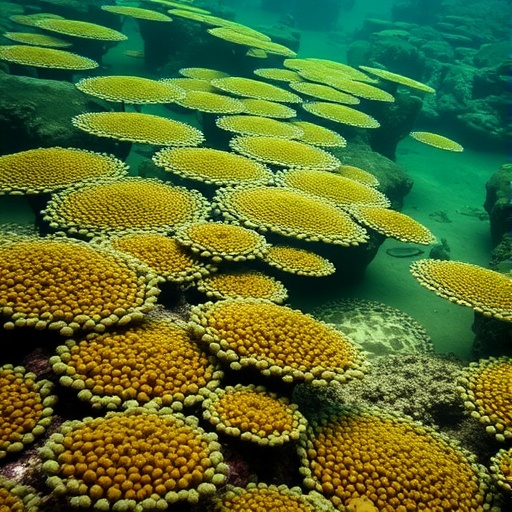In the vibrant ecosystems of lakes, microorganisms play essential roles, but their presence can sometimes lead to dire consequences. Among these harmful microbes, cyanobacteria produce a toxic compound known as microcystin-LR, a substance notorious for its detrimental effects on both aquatic life and human health. Recent research conducted in a warm monomictic lake in south-central Chile sheds light on the persistent nature of this toxin amidst growing anthropogenic pressures.
The aforementioned study investigates the behavior of microcystin-LR in an environment marked by rising temperatures and human activity. Monomictic lakes, characterized by their single period of turnover each year, are particularly sensitive to climatic and environmental changes. As global temperatures continue to rise, the implications for these ecosystems become increasingly significant, raising concerns among scientists and public health officials alike. The findings from this study elucidate an urgent need to monitor, manage, and mitigate the impacts of cyanotoxins in freshwater sources.
Researchers initiated their study by assessing the concentrations of microcystin-LR in this lake, juxtaposing its levels against varying climatic conditions and anthropogenic influences. The results unveiled a troubling trend: escalating temperatures contributed to increased concentrations of the toxin. This underscores the intricate relationship between climate change and freshwater ecosystems. As temperatures rise, the potential for harmful algal blooms also heightens, leading to greater risks for water quality and safety.
In conjunction with temperature assessments, the study closely examined the neighboring human activities that contribute to the lake’s deterioration. Urban runoff, agricultural runoff, and waste discharge were identified as significant factors exacerbating the influx of nutrients like nitrogen and phosphorus into the water system. These nutrients foster the growth of cyanobacteria, creating an environment ripe for the production of microcystin-LR. With an ever-increasing human footprint, the balance of these fragile ecosystems hangs in the balance.
To better understand the long-term implications of microcystin-LR persistence, researchers implemented rigorous sampling and analytical techniques. The analysis involved a combination of water sampling, spectrophotometry, and genomic assessments of local cyanobacterial populations. This comprehensive approach not only demonstrated the prevalence of microcystin-LR but also provided valuable insights into the strain of cyanobacteria responsible for its production.
The study’s findings revealed that the toxicity levels are not only alarming but also raise pressing questions regarding public health and safety in communities relying on this water source. The authors emphasize that microcystin-LR can lead to severe health risks ranging from liver damage to increased cancer risks in humans. As such, it is crucial for local governments and health organizations to prioritize monitoring efforts and develop strategies aimed at reducing these health hazards.
As part of their conclusion, the researchers advocate for a multi-faceted management strategy that encompasses pollution control, community awareness, and active monitoring of water quality. Implementing policies to limit nutrient loading into the lake can significantly help mitigate the risk of harmful algal blooms and associated toxins. Community education is equally important, as it can empower local residents to make informed decisions about water use and conservation practices.
What’s more, the implications of this research extend beyond regional boundaries. As multitudes of lakes globally face similar challenges, the lessons learned from this study offer a valuable template for addressing cyanobacterial toxicology in the wake of climate change. Policymakers and scientists alike must recognize the pivotal role that ongoing research plays in comprehending the complexities of these ecosystems and their susceptibility to human-induced changes.
In the face of escalating environmental concerns, the fight against microcystin-LR pollution must advance. Collaborative efforts between scientists, healthcare professionals, and local authorities will be crucial in developing sustainable practices that combat this pressing issue. The pursuit of cleaner, healthier lakes is not merely an environmental challenge but a vital public health initiative that can shape the future of water safety for generations to come.
This investigation serves as a clarion call for ongoing monitoring and research into harmful algal blooms and their toxins. The intertwined fates of human health and ecological balance must not be treated as isolated issues but rather as parts of a larger narrative in which both are equally vital. Enhanced understanding of the persistence of microcystin-LR in warm monomictic lakes like the one studied is essential for crafting effective interventions.
In conclusion, the findings underscore the need for vigilance against the rising threat posed by microcystin-LR in freshwater systems. The persistence of this toxin in the face of human encroachment and climate change necessitates concerted actions across all sectors—from scientific research to community engagement—to ensure that these vital water resources continue to support both ecological integrity and human wellbeing. The fight against these toxins has only just begun.
Subject of Research: Persistence of microcystin-LR in a warm monomictic lake under anthropogenic pressure in south-central Chile.
Article Title: Persistence of microcystin-LR in a warm monomictic lake under anthropogenic pressure in south-central Chile.
Article References: Reyes-Quinteros, N., González-Saldía, R., Leal-Medina, C. et al. Persistence of microcystin-LR in a warm monomictic lake under anthropogenic pressure in south-central Chile. Environ Monit Assess 197, 1320 (2025). https://doi.org/10.1007/s10661-025-14782-0
Image Credits: AI Generated
DOI: https://doi.org/10.1007/s10661-025-14782-0
Keywords: microcystin-LR, cyanobacteria, monomictic lakes, climate change, anthropogenic pressure, freshwater ecosystems, water quality, public health, algal blooms, nutrient loading, pollution control, environmental management, health risks, community awareness.




